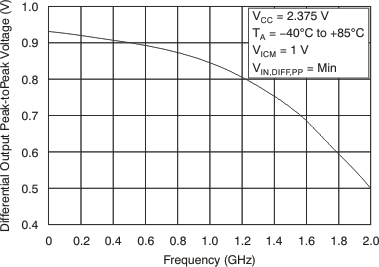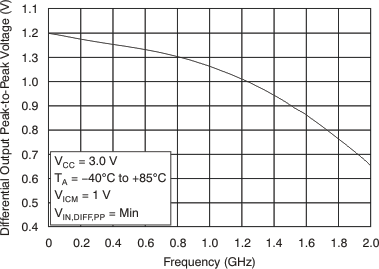SCAS884D August 2009 – December 2015 CDCLVP1102
PRODUCTION DATA.
- 1 Features
- 2 Applications
- 3 Description
- 4 Revision History
- 5 Pin Configuration and Functions
-
6 Specifications
- 6.1 Absolute Maximum Ratings
- 6.2 ESD Ratings
- 6.3 Recommended Operating Conditions
- 6.4 Thermal Information
- 6.5 Electrical Characteristics: LVCMOS Input
- 6.6 Electrical Characteristics: Differential Input
- 6.7 Electrical Characteristics: LVPECL Output
- 6.8 Electrical Characteristics: LVPECL Output
- 6.9 Typical Characteristics
- 7 Parameter Measurement Information
- 8 Detailed Description
- 9 Application and Implementation
- 10Power Supply Recommendations
- 11Layout
- 12Device and Documentation Support
- 13Mechanical, Packaging, and Orderable Information
パッケージ・オプション
メカニカル・データ(パッケージ|ピン)
- RGT|16
サーマルパッド・メカニカル・データ
- RGT|16
発注情報
6 Specifications
6.1 Absolute Maximum Ratings
over operating free-air temperature range (unless otherwise noted)(1)| MIN | MAX | UNIT | ||
|---|---|---|---|---|
| VCC | Supply voltage range(2) | –0.5 | 4.6 | V |
| VIN | Input voltage range (3) | –0.5 | VCC + 0.5 | V |
| VOUT | Output voltage range (3) | –0.5 | VCC + 0.5 | V |
| IIN | Input current | 20 | mA | |
| IOUT | Output current | 50 | mA | |
| TA | Specified free-air temperature (no airflow) | –40 | 85 | °C |
| TJ | Maximum junction temperature | 125 | °C | |
| Tstg | Storage temperature | –65 | 150 | °C |
(1) Stresses beyond those listed under Absolute Maximum Ratings may cause permanent damage to the device. These are stress ratings only, which do not imply functional operation of the device at these or any other conditions beyond those indicated under Recommended Operating Conditions. Exposure to absolute-maximum-rated conditions for extended periods may affect device reliability.
(2) All supply voltages must be supplied simultaneously.
(3) The input and output negative voltage ratings may be exceeded if the input and output clamp-current ratings are observed.
6.2 ESD Ratings
| VALUE | UNIT | |||
|---|---|---|---|---|
| V(ESD) | Electrostatic discharge | Human-body model (HBM), per ANSI/ESDA/JEDEC JS-001(1) | ±2000 | V |
(1) JEDEC document JEP155 states that 500-V HBM allows safe manufacturing with a standard ESD control process.
6.3 Recommended Operating Conditions
over operating free-air temperature range (unless otherwise noted)| MIN | NOM | MAX | UNIT | ||
|---|---|---|---|---|---|
| VCC | Supply voltage | 2.375 | 2.50/3.30 | 3.60 | V |
| TA | Ambient temperature | –40 | 85 | °C | |
| TPCB | PCB temperature (measured at thermal pad) | 105 | °C | ||
6.4 Thermal Information
| THERMAL METRIC(1)(2)(3) | CDCLVP1102 | UNIT | ||
|---|---|---|---|---|
| RGT (VQFN) | ||||
| 16 PINS | ||||
| RθJA | Junction-to-ambient thermal resistance | 0 LFM(4) | 51.8 | °C/W |
| 150 LFM(4) | 45 | |||
| 400 LFM(4) | 40.8 | |||
| RθJC(top) | Junction-to-case (top) thermal resistance | 61.3 | °C/W | |
| RθJB(5) | Junction-to-board thermal resistance | 21.7 | °C/W | |
| ψJT | Junction-to-top characterization parameter | 1.5 | °C/W | |
| ψJB | Junction-to-board characterization parameter | 21.7 | °C/W | |
| RθJC(bot) | Junction-to-case (bottom) thermal resistance | 6.3 | °C/W | |
(1) For more information about traditional and new thermal metrics, see the Semiconductor and IC Package Thermal Metrics application report (SPRA953).
(2) The package thermal resistance is calculated in accordance with JESD 51 and JEDEC 2S2P (high-K board).
(3) Connected to GND with four thermal vias (0.3-mm diameter).
(4) 2 x 2 vias on Pad
(5) θJP (junction-to-pad) is used for the QFN package, because the primary heat flow is from the junction to the GND pad of the QFN package.
6.5 Electrical Characteristics: LVCMOS Input
at VCC = 2.375 V to 3.6 V and TA = –40°C to 85°C and TPCB ≤ 105°C (unless otherwise noted)(1)6.6 Electrical Characteristics: Differential Input
at VCC = 2.375 V to 3.6 V and TA = –40°C to 85°C and TPCB ≤ 105°C (unless otherwise noted)(1)| PARAMETER | TEST CONDITIONS | MIN | TYP | MAX | UNIT | |
|---|---|---|---|---|---|---|
| fIN | Input frequency | Clock input | 2000 | MHz | ||
| VIN, DIFF, PP | Differential input peak-peak voltage | fIN ≤ 1.5 GHz | 0.1 | 1.5 | V | |
| 1.5 GHz ≤ fIN ≤ 2 GHz | 0.2 | 1.5 | V | |||
| VICM | Input common-mode level | 1 | VCC – 0.3 | V | ||
| IIH | Input high current | VCC = 3.6 V, VIH = 3.6 V | 40 | μA | ||
| IIL | Input low current | VCC = 3.6 V, VIL = 0 V | –40 | μA | ||
| ΔV/ΔT | Input edge rate | 20% to 80% | 1.5 | V/ns | ||
| ICAP | Input capacitance | 5 | pF | |||
6.7 Electrical Characteristics: LVPECL Output
at VCC = 2.375 V to 2.625 V and TA = –40°C to 85°C and TPCB ≤ 105°C (unless otherwise noted)(1)| PARAMETER | TEST CONDITIONS | MIN | TYP | MAX | UNIT | |
|---|---|---|---|---|---|---|
| VOH | Output high voltage | TA ≤ 85ºC | VCC – 1.26 | VCC – 0.9 | V | |
| TPCB ≤ 105ºC | VCC – 1.26 | VCC – 0.83 | V | |||
| VOL | Output low voltage | TA ≤ 85ºC | VCC – 1.7 | VCC – 1.3 | V | |
| TPCB ≤ 105ºC | VCC – 1.7 | VCC – 1.25 | V | |||
| VOUT, DIFF, PP | Differential output peak-peak voltage | fIN ≤ 2 GHz | 0.5 | 1.35 | V | |
| VAC_REF | Input bias voltage(2) | IAC_REF = 2 mA | VCC – 1.6 | VCC – 1.1 | V | |
| tPD | Propagation delay | VIN, DIFF, PP = 0.1 V | 450 | ps | ||
| VIN, DIFF, PP = 0.3 V | 450 | ps | ||||
| tSK,PP | Part-to-part skew | 100 | ps | |||
| tSK,O | Output skew | 10 | ps | |||
| tSK,P | Pulse skew (with 50% duty cycle input) | Crossing-point-to-crossing-point distortion, fOUT = 100 MHz | –50 | 50 | ps | |
| fOUT = 100 MHz, VIN,SE = VCC, Vth = 1.25 V, 10 kHz to 20 MHz |
0.089 | ps, RMS | ||||
| fOUT = 100 MHz, VIN,SE = 0.9 V, Vth = 1.1 V, 10 kHz to 20 MHz |
0.093 | ps, RMS | ||||
| tRJIT | Random additive jitter (with 50% duty cycle input) | fOUT = 2 GHz, VIN,DIFF,PP = 0.2 V, VICM = 1 V, 10 kHz to 20 MHz |
0.037 | ps, RMS | ||
| fOUT = 100 MHz, VIN,DIFF,PP = 0.15 V, VICM = 1 V, 10 kHz to 20 MHz |
0.094 | ps, RMS | ||||
| fOUT = 100 MHz, VIN,DIFF,PP = 1 V, VICM = 1 V, 10 kHz to 20 MHz |
0.091 | ps, RMS | ||||
| tR/tF | Output rise/fall time | 20% to 80% | 200 | ps | ||
| IEE | Supply internal current | Outputs unterminated, TA ≤ 85ºC |
33 | mA | ||
| Outputs unterminated, TPCB ≤ 105ºC |
34 | mA | ||||
| ICC | Output and internal supply current | All outputs terminated, 50 Ω to VCC – 2, TA ≤ 85ºC |
100 | mA | ||
| All outputs terminated, 50 Ω to VCC – 2, TPCB ≤ 105ºC |
105 | mA | ||||
6.8 Electrical Characteristics: LVPECL Output
at VCC = 3.0 V to 3.6 V and TA = –40°C to 85°C and TPCB ≤ 105°C (unless otherwise noted)(1)6.9 Typical Characteristics
at TA = –40°C to 85°C (unless otherwise noted)
